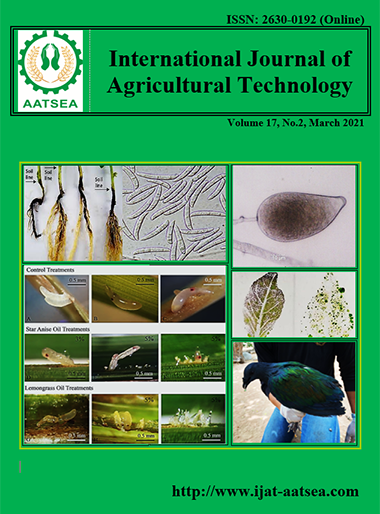Evaluation of tomatoes fruits flesh colour, beta-carotene and lycopene content
Main Article Content
Abstract
The phenotypes of tomatoes in various varieties (lines) were investigated including lycopene and beta-carotenet contents on tomato flesh fruits. Results showed that the fruits of var SL08 (N30B Orange) gave the highest lycopene and tomato var SA (40A Red) gave the lowest lycopene. Moreover, tomato var. SL06 (39B Pink) has the highest beta-carotene content and tomato var. SL02 (33A Yellow-Orange) has the lowest beta-carotene content. It can be concluded that phenotype characters of tomato varieties (lines) in colour of flesh fruits are related to lycopene and beta-carotene content. These preliminary results can be used for further investigation of different genotypes of tomato and relate its fruit flesh colour to the expression of target genes, lycopene beta-cyclase and lycopene epsilon-cyclase genes.
Article Details

This work is licensed under a Creative Commons Attribution-NonCommercial-NoDerivatives 4.0 International License.
References
Aguirre, N. C. and Cabrera, F. A. V. (2012). Evaluating the fruit production and quality of Cherry Tomato (Solanum lycopersicum var. cerasiforme). Revista Facultad Nacional de Agronomía Medellín, 65:6593-6604.
Alsina, I., Dubova, L., Duma, M., Erdberga, I., Avotiņš, A. and Rakutko, S. (2019). Comparison of lycopene and β-carotene content in tomatoes determined with chemical and non-destructive methods. Agronomy Research, 17:343-348.
Apel, W. and Bock, R. (2009). Enhancement of carotenoid biosynthesis in transplastomic tomatoes by induced lycopene-to-provitamin A conversion. Plant Physiology, 151:59-66.
Biswas, A. K., Sahoo, J. and Chatli, M. K. (2011). A simple UV-Vis spectrophotometric method for determination of β-carotene content in raw carrot, sweet potato and supplemented chicken meat nuggets. LWT - Food Science and Technology, 44:1809-1813.
Brandt, S., Pek, Z. and Barna, E. (2006). Lycopene content and colour of ripening tomatoes as affected by environmental conditions. Journal of the Science of Food and Agriculture, 86:568-572.
Cazzonelli, C. I. and Pogson, B. J. (2010). Source to sink: Regulation of carotenoid biosynthesis in plants. Trends Plant Science, 15:266-274. DOI: 10.1016/j.tplants.2010.02.003.
D’Ambrosio, C., Stigliani, A. L. and Giorio, G. (2018). CRISPR/Cas9 editing of carotenoid genes in tomato. Transgenic Research, 27:367-378. https://doi.org/10.1007/s11248-018-0079-9
Gastélum-Barrios, A., Bórquez-López, R. A., Rico-García, E., Toledano-Ayala, M. and Soto-Zarazúa, G. M. (2011). Tomato quality evaluation with image processing: A review. African journal of agricultural research, 6:3333-3339.
He, Z., Wang, S., Yang, Y., Hu, J., Wang, C., Li, H., Ma, B. and Yuan, Q. (2017). β Carotene production promoted by ethylene in Blakeslea trispora and the mechanism involved in metabolic responses Process Biochemistry, 57:57-63.
Howitt, C. A. and Pogson, B. J. (2006). Carotenoid accumulation and function in seeds and non-green tissues. Plant Cell Environ, 29:435-445 (DOI: 10.1111/j.1365-3040.2005. 01492.x
Ibrahim, A. O., Abdul-Hammed, M., Adegboyega, S. A., Olajide, M. and Aliyu, A. A. (2019). Influence of the techniques and degrees of ripeness on the nutritional qualities and carotenoid profiles of Tomatoes (Solanum lycopersicum). Annals of Science and Technology, 4:48-55.
Kondratieva, I. Y. and Golubkina, N. A. (2016). Licopene and B-carotene in tomato. Vegetable crops of Russia, 4:80-83.
Li, X., Wang, Y., Chen, S., Tian, H., Fu, D., Zhu, B., Luo, Y. and Zhu, H. (2018). lycopene is enriched in tomato fruit by CRISPR/Cas9-Mediated multiplex genome editing. Front. Plant Science, 9:559. doi: 10.3389/fpls.2018.00559
Malgorzata B., Schutze, W. and Schulz, H. (2007). Determination of lycopene and β-carotene content in tomato fruits and related products: Comparison of FT-Raman, ATR-IR, and NIR Spectroscopy. Analytical Chemistry, 78:8456-61.
McQuinn, R. P., Wong, B. and Giovanni, J. J. (2018). AtPDS overexpression in tomato: exposing unique patterns of carotenoid self-regulation and an alternative strategy for the enhancement of fruit carotenoid content. Plant Biotechnology Journal, 16:482-494.
Nagata, M. and Yamashita I. (1992). Simple method for simultaneous determination of chlorophyll and carotenoids in tomato fruit. The Japanese Society of Food Science and Technology, 39:925-928.
Shi, Y., Wang, R., Luo, Z., Jin, L., Liu, P., Chen, Q., Li, Z., Li, F., Wei, C., Wu, M., Wei, P., Xie, H., Qu, L., Lin, F. and Yang, J. (2014). Molecular cloning and functional characterization of the lycopene ε-cyclase gene via virus-induced gene silencing and its expression pattern in nicotiana tabacum. International Journal of Molecular Sciences, 15:14766-14785.
Szuvandzsiev, P., Helyes, L., Lugasi, A., Szanto, C., Baranowski, P. and Pek, Z. (2004). Estimation of antioxidant components of tomato using VIS-NIR reflectance data by handheld portable spectrometer. International Agrophysics, 28:4.
Takahashi, N., Yokayama, N., Takayama, K. and Nishina, H. (2018). Estimation of tomato fruit lycopene content after storage at different storage temperatures and durations. Environmental Control in Biology, 56:157-160.
Vilbett, B. L., Claudia, G. V. and Raúl, C. S. (2019). Optimization of extraction yield, flavonoids and lycopene from tomato pulp by high hydrostatic pressure-assisted extraction. Food Chemistry, 278:751-759.
Yu, B., Lydiate, D. J., Young, L. W., Schäfer, U. A. and Hannoufa, A. (2008). Enhancing the carotenoid content of Brassica napus seeds by downregulating lycopene epsilon cyclase. Transgenic Research, 17:573-585.
Global Tomato Industry Report (2020). Trends & opportunities by country, consumption, production, price developments, imports and exports (2007-2025). Retrived from https://www.globenewswire.com/news-release/2020/02/14/1985135/0/en/Global-Tomato-Industry-Report-2020-Trends-Opportunities-by-Country-Consumption-Production-Price-Developments-Imports-and-Exports-2007-2025.html


